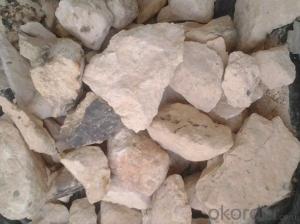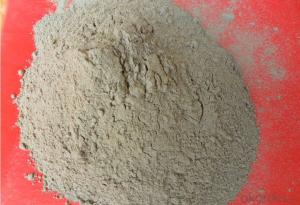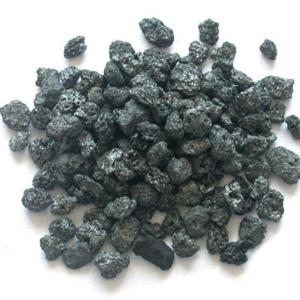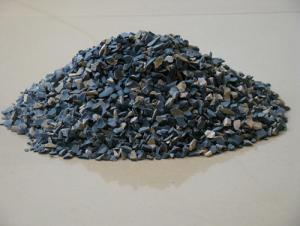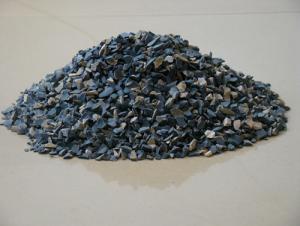China Natural Refractory Calcined Bauxite Low Price with Detailed Specifications
- Loading Port:
- Tianjin
- Payment Terms:
- TT or LC
- Min Order Qty:
- 111 m.t
- Supply Capability:
- 11111111 m.t/month
OKorder Service Pledge
OKorder Financial Service
You Might Also Like
1.Structure of Calcined Bauxite Description
Bauxite (aluminous soil; Bauxite) is also called the alumina or bauxite, main ingredients are alumina, hydrated alumina containing impurities, is an earthy mineral. White or gray, brown and yellow or light red by iron. From 4 to 3.9 g/cm3 density, hardness, 1 ~ 3 is not transparent, very brittle. Very difficult to melt. Insoluble in water, soluble in sulfuric acid, sodium hydroxide solution. Mainly used for aluminium, refractory material.
2.Main Features of the Calcined Bauxite
Calcined bauxite is one of the principal ore of aluminum. Calcined bauxite contains hydrous aluminum oxides and aluminum
hydroxides, formed through the laterization of aluminous rocks in tropical and subtropical areas .Calcined bauxite is obtained by calcining (heating)superior grade bauxite at high temperature (from 85OC to 1600C) .This removes moisture there.By increasing the alumina content,compared to an alumina content of about 57%to 58% in raw bauxite, calcined bauxite has an alumina content of 84%to88%.The heating is carried out in rotary kilns.
3.Main usage of the Calcined Bauxite
(1) aluminium industry. Used in national defense, aerospace, automotive, electronics, chemical industry, daily necessities, etc.
(2) precision casting. Alumina clinker made after the mould precision casting processed into fine powder. Used in military industry, aerospace, communications, instrumentation, machinery and medical equipment department.
(3) is used for refractory products. High bauxite clinker refractoriness is as high as 1780, chemical stability strong, and good physical properties.
(4) aluminum silicate refractory fiber. With light weight, high temperature resistance, good thermal stability, low thermal conductivity, heat capacity is small and the advantages of resistance to mechanical shock. Used in iron and steel, nonferrous metallurgy, electronics, petroleum, chemical, aerospace, atomic energy, defense and other industries.
(5) in magnesia and bauxite clinker as raw materials, add the appropriate binder, used for pouring ladle whole ladle lining has particularly good effects.
(6) manufacture alumina cement, abrasive materials, ceramic industry and chemical industry can be aluminum of various compound.
4. Calcined Bauxite Images

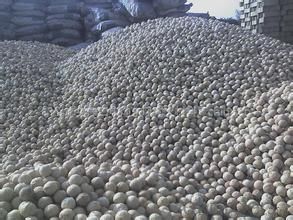
5. Calcined Bauxite Specification
Grade | AL2O3 | SIO2 | FE2O3 | TIO2 | K2O+Na2O | CaO+MgO | Bulk density |
HX75 | 75min | ≤17 | ≤3.0 | ≤4.0 | ≤0.3 | ≤0.5 | ≥2.70 |
HX80 | 80min | ≤12 | ≤3.0 | ≤4.0 | ≤0.3 | ≤0.5 | ≥2.80 |
HX85 | 85min | ≤8 | ≤2 | ≤4.0 | ≤0.3 | ≤0.5 | ≥3.00 |
HX86 | 86min | ≤7 | ≤2 | ≤4.0 | ≤0.3 | ≤0.5 | ≥3.10 |
HX87 | 87min | ≤6 | ≤2 | ≤4.0 | ≤0.3 | ≤0.5 | ≥3.20 |
HX88 | 88min | ≤5 | ≤1.8 | ≤4.0 | ≤0.25 | ≤0.5 | ≥3.25 |
HX90 | 90min | ≤3 | ≤1.8 | ≤4.0 | ≤0.25 | ≤0.5 | ≥3.3 |
Moisture(max) | 0.50% | ||||||
6.FAQ of Calcined Bauxite
1). Q: Are you a factory or trading company?
A: We are a factory.
2). Q: Where is your factory located? How can I visit there?
A: Our factory is located in ShanXi, HeNan, China. You are warmly welcomed to visit us!
3). Q: How can I get some samples?
A: Please connect me for samples
4). Q: Can the price be cheaper?
A: Of course, you will be offered a good discount for big amount.
- Q:which kind of material should be used in fireproofing cabinet?
- Here are a few good materials: 1. The mineral wool board, glass wool board: it mainly tales mineral wool, glass wool as insulation materials. It's non-combustible, light weight and has good high temperature resistance, but there are shortcomings ① short?fiber will harm the human respiratory system, ② poor sheet strength, ③ poor barrier property of sheet for smoke of fire disaster, ④ poor decorative properity, ⑤large installment and construction work. Thus, most of the boards were sheets that take inorganic anchoring material as base material, glass wool as reinforcing material. 2. cement board: Cement board has high strength and wide sources. It is often used in fireproof suspended?ceiling and partition in the past, but it has poor fire resistance and is easy to burst and lose protective function , which will limit it's applications. Cement concrete component has good thermal insulation and sound insulation properties, and it can be used as partition and roof board. Fiber reinforced cement board and other improved varieties appear in the construction?materials market, and they are high strength and have good fire resistance, but their disadvantages are poor toughness, large alkalinity and poor decoration effect. 3. perlite board, cenosphere board, vermiculite board: It's a kind of hollow plate that takes low alkalinity cement as base material, perlite, glass beads, vermiculite as the aerated filling material, and is made by adding some auxiliary. It has characteristics of light weight, high strength, good toughness, fireproofing and thermal insulation, easy for construction,etc. and it can be widely used in high-rise building frame compartment, household, bathroom, kitchen, communication pipe and other non-load bearing areas.
- Q:I am a manufacturer of refractory materials. I would like to receive some orders from abroad. I would like to know what foreign trade companies in Dalian place foreign orders abroad
- You don't give a cent to this question, no one will answer it
- Q:What are grades of refractory materials?
- Refractories have lots of varieties which all have different purposes. It is necessary to classify refractories scientifically in order to scientifically study, choose and manage them. Classification methods of refractories include chemical properties classification, chemical composition of mineral classification, manufacturing technique classification, morphology of the material classification. 1 divided according to the level of refractoriness: ordinary refractory materials: 1580 ℃ ~ 1770 ℃, advanced refractories: 1770 ℃ ~ 2000 ℃ and super refractories: above 2000 ℃ 2, divided in accordance with shapes and sizes : Standard ones: 230mm × 113mm × 65mm, no more than four ruler.
- Q:How long is the fire endurance of fire resistant rolling shutter door?
- According to the new national standards GB_12955-2008 for fire doors from January 1, 2009, fire doors are classified acoording to thermal insulation fireproof door(A),part heat insulation fireproof door(B) and non thermal insulation fireproof door(C), rather than thermal insulation fireproof door. At the same time, the original fire endurances of class A, B and C fire doors are adjusted to 1.5h, 1.0h and 0.5h respectively. So, GB is 1.5h
- Q:What are the new types of refractories? What are the characteristics? Their applications and developments?
- Special materials often use AZS brick, corundum brick, magnesia chrome brick, silicon carbide, silicon nitride bonded silicon carbide, nitrides, silicides, sulfide, boride, carbide and other non oxide refractory materials; calcium oxide, chromium oxide, alumina, Magnesium Oxide, beryllium and other refractory materials. Often used insulation refractories are diatomite products, asbestos products, insulation panels and so on. Unshaped refractory materials commonly used are fettling, refractory ramming material, refractory castable, refractory plastic material, refractory clay, refractory gunning, refractory cast material, fireproof coating, lightweight castable, mud etc..
- Q:Are fire materials poisonous after burning?
- Neutral refractory is mainly composed of alumina, chromium oxide or carbon. Corundum products containing more than 95% of alumina are a kind of high quality refractory materials with a wide range of uses. Chrome brick with chromium oxide as its main component has good corrosion resistance, but its thermal shock resistance is poor, and its deformation temperature is lower at high temperature. Carbon refractories with carbon bricks, graphite and silicon carbide products, low coefficient of thermal expansion, high thermal conductivity, good thermal shock resistance, high strength, resistance to acid and salt corrosion, especially weak acid has good resistance, without wetting of the metal and slag, light. It is widely used as lining material of high temperature, and also used as lining of autoclave in petroleum and chemical industry.
- Q:Can anyone say something about what A-level fire-proof decorative material is?
- Now A-level market is very confusing. The major products are material monomer A-level and composite A-level, now a lot of B-level material is wrapped in calcium silicate board. The foam cement overall composite is level A, such as phenolic aldehyde composite, as well as some of the foam paddings, while monomer A-level includes rock wool, ultra-thin insulation panel and the like.. But there are few products with real sound A level qualification. Many manufacturers are playing the edge ball with A-level fire rating examining reports and B-level system detection reports and records, but this situation will not last long, which will soon be clear. I hope the information above can help you. Hope you adopt
- Q:How is the grading of the level A new material fire insulation material?
- The standard to distinguish level A and level B is the different fireproofing coefficient. The level A is non-combustible. The level B is divided into B1, B2 and B3. B1 is flame retardant, B2 combustible and B3 flammable. The level A is commonly phenolic aldehyde, rock wool, thermal?mortar, foam ceramics, foam glass and foam concrete on the current market. Among the advantages of level A materials, the biggest one is foam concrete currently, also known as foam cement.
- Q:Concrete composition and function of magnesia bond used in refractory
- Mainly high purity magnesia powder and silica fume, in accordance with the 4:1 ratio of the mixture, that is, we often use in the castable MgO-SiO2-H2O binding system! Compared with cement, the content of CaO is lower, the high temperature strength of the product is increased, and the slag corrosion resistance of the product is increased!
- Q:What are the refractories for converter?
- Permanent layer (sintering) magnesia brick, the working lining gunning material for the working layer and the permanent layer gap, using magnesia ramming materials, MgO-C brick brick supply,
1. Manufacturer Overview |
|
|---|---|
| Location | |
| Year Established | |
| Annual Output Value | |
| Main Markets | |
| Company Certifications | |
2. Manufacturer Certificates |
|
|---|---|
| a) Certification Name | |
| Range | |
| Reference | |
| Validity Period | |
3. Manufacturer Capability |
|
|---|---|
| a)Trade Capacity | |
| Nearest Port | |
| Export Percentage | |
| No.of Employees in Trade Department | |
| Language Spoken: | |
| b)Factory Information | |
| Factory Size: | |
| No. of Production Lines | |
| Contract Manufacturing | |
| Product Price Range | |
Send your message to us
China Natural Refractory Calcined Bauxite Low Price with Detailed Specifications
- Loading Port:
- Tianjin
- Payment Terms:
- TT or LC
- Min Order Qty:
- 111 m.t
- Supply Capability:
- 11111111 m.t/month
OKorder Service Pledge
OKorder Financial Service
Similar products
New products
Hot products
Hot Searches
Related keywords

